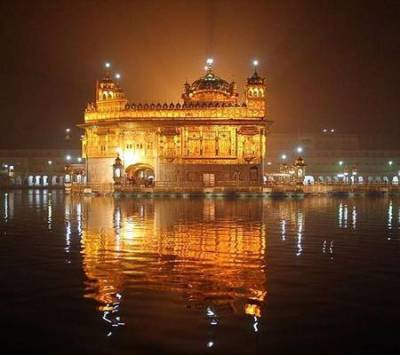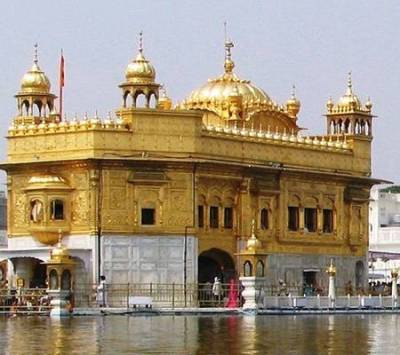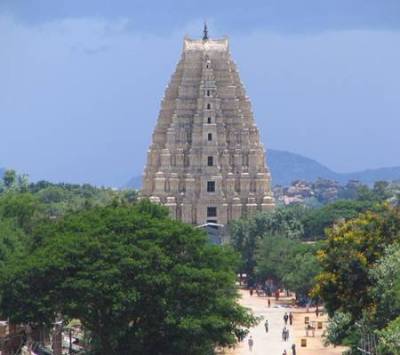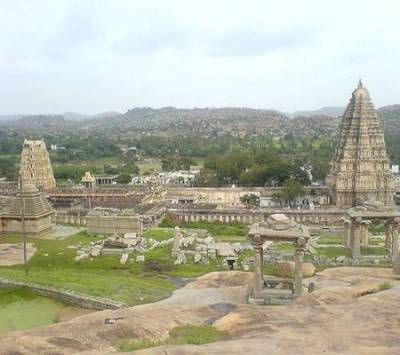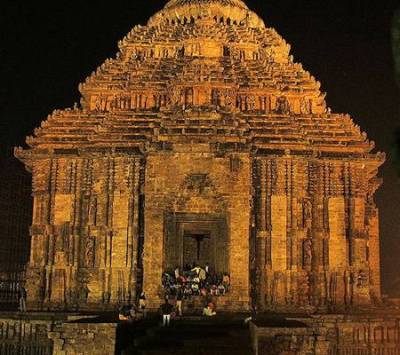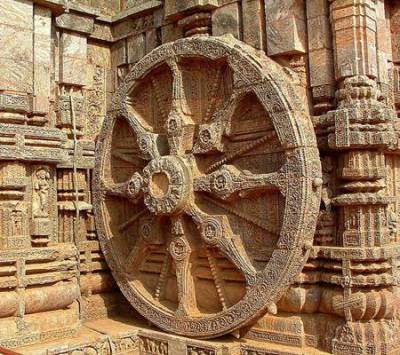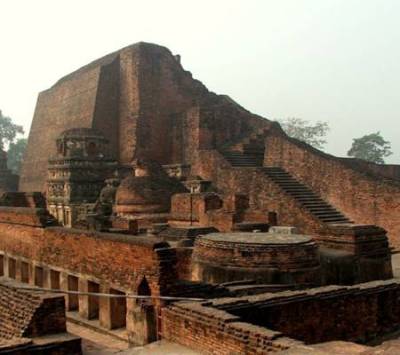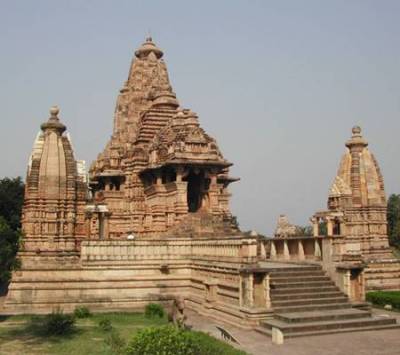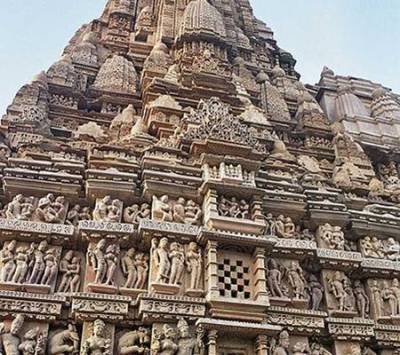India – Stats, Facts, Trivia
Sun14Aug11
7 Wonders of Ancient India
Mon08Nov10
[1] SHRAVANABELAGOLA or GOMATESHWARA

The 17.8 m monolith of Jain prophet Bhagavan Gomateshwara Bahubali, which was carved out around 983 C.E and is located in Shravanabelagola, India, is anointed with saffron every 12 years by thousands of devotees as part of the Mahamastakabhisheka festival. The colossal monolithic statue of Gomateshwara (Shravanabelagola is a synonymous word), also called as Bahubali the Jain saint, created around 983 C.E by Chamundaraya, a minister of the Ganga King, Rachamalla (Raachmalla SathyaVaak IV 975-986 C.E) is located atop the Chandragiri hill (618 steps climb leads to the monolith on the hill), near the town of Shravanabelagola in Karnataka state. This statue is said to have been carved out of a single block of fine-grained white granite and is considered of great religious significance because Jains believe Bahubali was the first to attain moksha (freedom from cycle of birth and death). The image stands on a lotus. It has no support up to the thighs and is 60 feet (18 m) tall with the face measuring 6.5 feet (2.0 m). The statue is completely in the nude, in the Jain custom and is visible from a distance of 30 km.With the serene expression on the face of the image, its curled hair with graceful locks, its proportional anatomy, the monolith size, and the combination of its artistry and craftsmanship have led it to be called the mightiest achievement in sculptural art in medieval Karnataka. It is the largest monolithic statue in the world.
The neighbouring areas of Shravanabelagola, apart from the Gomateshwara statue, have Jaina bastis and several images of the Jaina Thirthankaras. A beautiful view of the surrounding areas could be seen from the top of the Chandragiri hill. Every 12 years, thousands of devotees congregate here to perform the Mahamastakabhisheka, a spectacular ceremony in which the thousand-year-old statue is anointed with milk, curds, ghee, saffron and gold coins. The anointing last took place in February 2006, and the next ceremony will occur in 2018.
[2] GOLDEN TEMPLE or HARMANDIR SAHIB
The Harmandir Sahib (The abode of God) Golden Temple (main building) Complex with Akal Takht Sahib.completed in August 1604 AD
The Harmandir Sahib (Punjabi) or Darbar Sahib, informally referred to as the Golden Temple or Temple of God, is culturally the most significant shrine of the Sikhs and one of the oldest Sikh Gurudwara. It is located in the city of Amritsar, which was established by Guru Ram Das, the fourth guru of the Sikhs and the city that it was built in, is also due to the shrine known as Amritsar.
The fourth Guru of Sikhism, Guru Ram Das, excavated a tank in 1577 C.E which subsequently became known as Amritsar or Amrit Sarovar (meaning: Pool of the Nectar of Immortality), giving its name to the city that grew around it. In due course, a splendid Sikh edifice, Harmandir Sahib (meaning: The abode of God) [6], rose in the middle of this tank and became the supreme centre of Sikhism. Its sanctum houses the Adi Granth, compiled by Guru Arjun Dev, comprising compositions of Sikh Gurus and other saints considered to have Sikh values and philosophies e.g. Baba Farid, Kabir, etc. . Devotees, for whom the temple is a symbol of freedom and spiritual independence, come here from all over the world to enjoy its environs and offer their prayers. The Golden Temple sits on a rectangular platform, surrounded by a pool of water called the Amrit Sarovar. The temple building has four entrances instead of the usual single entry. This is symbolic of the openness of Sikhism and indicates that followers of all faiths are allowed inside. The walls within are decorated with carved wooden panels and elaborate inlay work in silver and gold. The Adi Granth, rests on a throne beneath a jewel-encrusted canopy. Priests conduct continuous recitation of verses from the holy book.
[3] TAJ MAHAL
Taj Mahal, built in the memory of the queen Mumtaz Mahal
Taj Mahal (also “the Taj”), the pinnacle of Mughal architecture, * Archeological Survey of India description was built by the Mughal emperor Shah Jahan in memory of his queen Mumtaz Mahal. It is considered the finest example of Mughal architecture, a style that combines elements from Persian, Turkish, Indian, and Islamic architectural styles. In 1983, the Taj Mahal became a UNESCO World Heritage Site and was cited as “the jewel of Muslim art in India and one of the universally admired masterpieces of the world’s heritage.” It is an integrated symmetric complex of structures that was completed around 1648. Ustad Ahmad Lahauri is generally considered to be the principal designer of the Taj Mahal.
The focus of the Taj Mahal is the white marble tomb, which stands on a square plinth consisting of a symmetrical building with an iwan, an arch-shaped doorway, topped by a large dome. Like most Mughal tombs, basic elements are Persian in origin. The base structure is a large, multi-chambered structure. The base is essentially a cube with chamfered edges and is roughly 55 meters on each side (see floor plan,
right). On the long sides, a massive pishtaq, or vaulted archway, frames the iwan with a similar arch-shaped balcony. On either side of the main arch, additional pishtaqs are stacked above and below. This motif of stacked pishtaqs is replicated on chamfered corner areas as well. The design is completely symmetrical on all sides of the building. Four minarets, one at each corner of the plinth, facing the chamfered corners, frame the tomb. The main chamber houses the false sarcophagi of Mumtaz Mahal and Shah Jahan; their actual graves are at a lower level. The exterior decorations of the Taj Mahal are among the finest to be found in Mughal architecture. The calligraphy found are of florid thuluth script, created by Persian calligrapher Amanat Khan.
Masons, stonecutters, inlayers, carvers, painters, calligraphers, dome-builders and other artisans were requisitioned from the whole of the empire and also from Central Asia and Iran to build the monument. While bricks for internal constructions were locally prepared, white marble for external use in veneering work was obtained from Makrana in Rajasthan. Semi-precious stones for inlay ornamentation were brought from distant regions of India, Ceylon (SriLanka) and Afghanistan. Red sandstone of different tints was requisitioned from the neighbouring quarries of Sikri, Dholpur. It took 17 years for the Taj to be built.
[4] HAMPI
Vijayanagar Raja Gopura at Hampi, Karnataka
The 14th century ruins nestle within them with almost every highlight of classical Indian architecture. Palaces, temples, marketplaces, watch towers, stables, baths and monoliths lie scattered amidst huge boulders, which complement the rugged look and historic feel of the place.
Ruins of Hampi – UNESCO World Heritage Site, presents the Vijayanagara architecture, a vibrant combination of the Chalukya, Hoysala, Pandya Chola styles, idioms that prospered in previous centuries. It Hampi was the last capital of the Vijayanagar Empire, which was admired by the travellers between the 14th and 16th centuries. But it was pillaged and abandoned by the Muslim confederacy which conquered the Deccan in 1565 C.E. Palaces, temples, marketplaces, watch towers, stables, baths and monoliths lie scattered amidst huge boulders, which complement the rugged look and historic feel of the place.
Its legacy of sculpture, architecture and painting influenced the development of the arts long after the empire came to an end. Its stylistic hallmark is the ornate pillared Kalyanamantapa (marriage hall), Vasanthamantapa (open pillared halls) and the Rajagopura (tower). While the empire’s monuments are spread over the whole of Southern India, nothing surpasses the vast open air theatre of monuments at its capital at Vijayanagara.
[5] KONARK
Konark sun temple at Night, Orissa Wheel of Konark Sun Temple
Konark Sun temple (also known as the Black Pagoda), was built in black granite by King Narasimhadeva I (1236 C.E-1264 C.E) of the Eastern Ganga Dynasty. The temple is a UNESCO-World Heritage Site. Built in the 13th century, the temple is designed in the shape of a colossal chariot with 24 wheels (3.3 m dia diameter each) drawn by seven horses and, carrying the Sun god, Surya, across the heavens.It is a stunning monument of religious (Brahmanical) architecture. The Sun temple belongs to the Kalinga School of Indian Temples with characteristic curvilinear towers mounted by cupolas and is aligned in the east-west direction as it is dedicated to Sun, which sun lits the entrance. The temple plan depicts three segments, viz., Natmandir (the outer complex), Jagmohan (the central complex) and Garbhagriha (the main complex housing the Deity). The main sanctum which (69.8 m. high) was constructed along with the audience hall (39.5 m. high) having elaborate external projections. The main sanctum which enshrined the presiding deity has fallen off. The Audience Hall survives in its entirely, but only small portions of the Dancing Hall (nata Mandir) and the Dining Hall (Bhoga-Mandap) have survived the vagaries of time. The Temple compound measures The Temple compound measures 857 ft (261 m) by 540 ft (160 m).
The entrance to the temple is guarded by two lions, each shown crushing a war elephant. Each elephant in turn is shown on top of a human body. At the entrance, there is also a Nata Mandir or dance hall where the temple dancers used to perform dances in homage to the Sun god. All around the temple, there are various floral and geometric patterns. There are also human, divine and semi-divine figures in sensuous poses. The poses contains couples in various amorous postures, and are derived from the Kama Sutra.
[6] NALANDA
The stupa of Sariputta at Nalanda.
The Nalanda, located in the Indian State of Bihar, was a Buddhist center of learning from 427 C.E to 1197 C.E partly under the Pala Empire. It has been called “one of the first great universities in recorded history.” According to historical studies the University of Nalanda was established 450 C.E under the patronage of the Gupta emperors, notably Kumaragupta. Nalanda, considered as the world’s first residential university, had dormitories for students and had accommodated over 10,000 students and 2,000 teachers. The university was considered an architectural masterpiece, and was marked by a lofty wall and one gate. Nalanda had eight separate compounds and ten temples, along with many other meditation halls and classrooms. On the grounds were lakes and parks. The library was located in a nine storied building where meticulous copies of texts were produced. The subjects taught at Nalanda University covered every field of learning, and it attracted pupils and scholars from Korea, Japan, China, Tibet, Indonesia, Persia and Turkey. The Tang Dynasty Chinese pilgrim Xuanzang left detailed accounts of the university in the 7th century.
[7] KHAJURAHO
Lakshmana temple at Khajuraho, a panchayatana temple. Khajuraho Temple, India
Khajuraho has the largest group of medieval (between 950 C.E and 1050 C.E) temples of Hindu and Jain religion. There is perfect fusion of architecture and sculpture at this temple complex, famous for their erotic sculpture. The temples are a UNESCO world Heritage Site. At the Temple of Kandariya, there is a profusion of decorated sculptures considered as one of the greatest masterpieces of Indian art. Built by Chandela dynasty, the temples exhibit stunningly explicit sexual sculptures which were created by the artist’s imagination of lovemaking positions prevalent at that time, or based on the rules outlined in the Kamasutra. Many of the sculptors have claimed artistic ownership on many sculptures. Built of sandstone in varying shades of buff, pink or pale yellow, most of the temples belong to the Shiva, Vaishnava or Jaina religious Sects, which are difficult to differentiate from one another. The temples, sited in an East-West direction, depicts a plan with spacious layout with interior rooms inter connected. An entrance, a hall, a vestibule and a sanctum are part the common layout plan of the temples. It is stated that the Khajuraho temples are a celebration of womankind, her innumerable moods and facets which are witnessed by the carvings of a woman writing letter, applying makeup to her eyes, combing her tresses, dancing, and playing with her child. Also etched, sculpted with consummate skill are innocent, coquettish, smiling, seductive, passionate and beautiful and erotic sculptures depicted in intricate detail. It is also opined that the Chandelas followed the Tantric cult with the faith that gratification of earthly desires is a step towards attaining Nirvana, the infinite liberation.
40 Mumbai Foods
Wed08Sep10
40 Bombay foods we cant live without by Sanjiv Khamgaonkar
From street food spice bombs to favorite fasting foods and meat dishes fit for a Mughal invader, here are a selection of foods that any true Mumbaiker revels in.
The history of food in Mumbai is closely linked to the growth of this city from fishing village to megapolis. As wave after wave of immigrants from all over the country came with dreams of gold in their eyes, they brought their culinary treasures with them. The result? A smorgasbord of cooking styles and street food that reflects our cosmopolitanism as much as our carbohydrate-fueled work ethic.
Here’s a sampling of 40 must-try foods that define Mumbai’s food culture, with Muslim, Gujarati, Goan, Coastal, South Indian, Parsi and of course local Maharashtran influences.
Parsi akuri, Mumbai’s scrambled eggs.
1. Akuri on toast
Move over scrambled eggs, the Parsi Akuri cometh. Rated as one of the great Parsi dishes, every family has its own special way of making this breakfast meal. Though variations of the ingredients are vociferously debated, Akuri is usually made by scrambling eggs with onions, tomatoes (or even raw mangoes when in season), red chilli powder, green chillies and topped with fresh coriander. Others add milk, jeera (cumin) powder, curry leaves and even ginger and garlic paste.
Try the Akuri on Toast at Jimmy Boy, 11 Bank Street, Vikas Building, Off Horniman Circle, Fort. Tel: +91 (0) 22 2266 2503
2. Baida roti
This one is an interesting envelope. Spiced meat — chicken or minced mutton, even bheja (brain) — and whipped eggs with masala-fied fried onions enveloped in a square shaped dough and pan fried. Though served with sliced onion rings and green chutney, they’re delicious even without accompaniment.
A lot of people swear by the Baida Roti at Bade Mian, Tullock Road, Behind Taj Mahal Hotel, Apollo Bunder, evenings only. Tel: +91 (0) 22 2284 8038
Batata vada, a Mumbai icon.
3. Batata vada
Whether it’s for breakfast, teatime, or anytime, one thing is for sure, Mumbaikars cant live without the Batata Vada bite. This well-liked fast food dumpling is made by mashing boiled potatoes with green chilies, ginger, garlic, lime juice, turmeric, and fresh coriander, then dipped in a besan (gram flour) batter and deep fried. It’s served either with a green chutney or fried green chillies.
Virtually every street corner will have an outstanding Batata Vada seller but its hard to beat the ones made at Shrikrishna, near Chabildas High School, Dadar Market.
4. Butter chicken
This ubiquitous dish traces its roots to the days of the Mughals when calorie counting was a thing of the future. This must-order dish when Indian families go out for dinner is made from chunks of chicken, marinated overnight in a yogurt and spice mix that includes ginger garlic paste and lime juice. It is then grilled or pan-fried. An ultra rich sauce made with butter, tomato puree, cumin, garam masalas and fresh cream is then poured over it. Best had with Indian breads like rotis, naan or parathas. Don’t confuse it with chicken tikka masala, which is a story for another day.
While available at every kind of eatery, the butter chicken at Punjab Grill is worth dying for. Level 3, Palladium Mall, Phoenix Mills, Lower Parel. Tel: +91 (0) 22 4347 3980
The classic Bombay Sandwich.
5. The Bombay sandwich
This street side invention is a combination of the most unlikely ingredients. Lavishly buttered white bread and sandwiched between them thin slices of beetroot, boiled potatoes, cucumbers, tomatoes, onion rings, and mint chutney. Cut into four triangles so that you can handle all the layers without spilling them, you get the most refreshing tangy taste, after each bite. A toasted version steams up the vegetables inside and adds another dimension. Truly, there is no other sandwich quite like it in the world.
Though widely available through out the city, try it at Amar Juice Centre, near Cooper Hospital, opp. Juhu Galli. Or the Mafco Stall outside Worli Dairy on Worli Sea Face.
Bheja fry, fried brain, not for the weak hearted.
6. Bheja fry
Bheja, or goat brain, sauted with tomatoes, onions, turmeric, green chillies, spices and garnished with fresh coriander, is a staple of all those with hardcore carnivorous leanings in the city. Eaten with a roti (Indian bread) or pao, this melt in the mouth dish has a rich Muslim heritage behind it and you often find that one plate is not enough.
Radio Restaurant, 10, Musafir Khana, Palton Road, Tel: +91 (0) 22 2261 7171, serves up a really good Bheja Fry.
Fried Bombil aka Bombay Duck.
7. Bombil fry
Bombil, or Bombay Duck, is a fish (and not a duck) found in plenty in the waters around Mumbai. A fisher folk favourite, Bombils are flattened, then dipped in a spice-filled besan (gram flour) batter and fried. This crunchy-on-the-outside and mushy-soft-on-the-inside fish dish can be eaten on its own as a starter, or as a main course with chapattis.
Gajalee restaurant does a mean Bombil Fry. They have branches at Hanuman Road, Vile Parle (E), Tel: +91 22 26114093. And at Phoenix Mills, Lower Parel, Tel: +91 22 2495 0667
8.. Brun maska
You may wonder how bread and butter can become such an iconic union. But it’s not merely bread and this is not merely butter. It’s brun or gutli pao — a local bread that is unique to Mumbai — and it’s crisp and hard and crumbly on the outside and soft inside. The Brun is then sliced and lashings of butter are applied lavishly. Some even sprinkle quite a bit of sugar. It is usually accompanied by the sweet Irani chai. Dipping the brun maska in the chai is the only way to eat it.
Available at most Irani restaurants, the Brun Maska at Kyani & Co is historic. 657 Jer Mahal Estate, Opp. Metro Cinema, Dhobi Talao, Tel: +91 (0) 22 2201 1492. Also try it at B Merwan, Opp. Grant Road Station (E), Tel: +91 (0) 22 2309 3321
Bhel puri at the Taj Hotel.
9. Bhel puri
The most commonly sold chaat on the streets of Mumbai, every bhel walla will have his own matchless blend and a considerable 7pm fan following. While the ingredients — puffed rice, papadi (small crisp deep fried flour puris), sev, onions, potatoes, raw mango and sweet and sour chutney — remain the same, it is the proportions in which they are thrown together on the street side that makes the difference.
Bhel puri is available everywhere. The stalls at Chowpatty and Juhu beaches draw throngs of die-hard fans. But if you want a bhel puri with ambience, try it at Sea Lounge, Taj Mahal Hotel, Apollo Bunder. Tel: +91 (0) 22 6665 3366
I often had it there. Obscenely expensive!! But it is quite worth the while especially when you are seated at the window overlooking the Gatway and the entrance to the harbour.
10. Chicken mayo roll
Almost every school or college canteen serves it. Most single screen cinema houses showing English movies display it during the interval. Most bakeries will have their version, neatly wrapped in cellophane, at the counter. Some grocery stores in up market areas stock it along with grain and rice. It’s hard to believe that plain boiled chicken doused in sweet-ish mayonnaise with a celery leaf for dressing, all wrapped up in a bread roll can be so popular in a spice loving city. But it is.
One of the creamiest chicken mayo rolls can be had at Paradise, Sindh Chambers, Shahid Bhagat Singh Road, Colaba, Tel: +91 22 22832874. Or try it at Candies, Mac Ronells, 5A Pali Hill, St. Andrews Road, Bandra (W). Tel: +91 22 26424125
11. Chicken manchurian
Here’s a dish that even the Chinese over on the mainland haven’t heard about. Snigger, snigger. Yet it’s on the menu of the roadside handcart Chinese food hawker and the Chinese restaurant in the fancy five-star hotel. Chicken manchurian, a phrase that has come to be the face of Chinese food in India, is nothing but deep-fried batter-coated chicken cubes in an onion, green chillies, garlic, vinegar and soy sauce gravy. Eaten with rice, it never fails to get a sigh of contentment from those partaking of this gastronomic oddity.
If you want to taste the real thing, try it where it was created, China Garden, Om Chambers, Kemps Corner. Tel: +91 (0) 22 2363 0841
Trishna’s butter pepper garlic crab.
12. Butter garlic crab
It doesn’t trace its roots to Chinese, Continental or Indian cuisines. It comes from Butter Land, an imagined place that thrives on the premise that anything tastes great with melted butter. A delicious, simple dish, a big crab is drowned in tons of butter garlic sauce that seeps into every nook and cranny and coats every morsel of the flesh. Crack open the crab and take a bite. Youll know immediately that sweet crabmeat and butter with a twist of garlic is a combination made by gods.
The best butter garlic crab can be found at Mumbai’s most famous seafood restaurant. Trishna, Sai Baba Marg, Near Rhythm House, Kala Ghoda, Fort. Tel: +91 22 22703213
13. Dhoklas and farsaan
These popular snacks are so integral to food loving Gujaratis that no meal is complete without them. And when traveling abroad, they dont leave home without a little parcel tucked away in their luggage. Dhoklas or ‘khummun’ are made from the fermented batter of chickpeas, steamed and then spiced with chillies and ginger and tempered with mustard seed.. Farsan, a broad term for savories encompassing sev and gathiya are crisp deep-fried spiced gram flour creations in pasta like shapes.
Several stores stock these popular snacks. But try them here: Chedda Dry Fruits & Snacks, 41 Ridge Road, Walkeshwar. Tel: +91 22 (0) 2369 9442. Dave Farsan Mart, 10 Babulnath Road, near Chowpatty. Tel: +91 (0) 22 6657 8311.. Go-Go Snacks, Bhavans College Lane, Chowpatty. Tel: +91 22 (0) 2361 9968.
Falooda, a desi dessert.
14. Falooda
This adaptation of a Persian dessert was brought to India by the Mughals. A rich drink, Falooda is vermicelli mixed with milk, almonds, pistachios, a bit of rose syrup and the key ingredient — sabza or basil seeds — topped up with two scoops of ice cream. Refreshing, rosy, energizing, it’s a great pick-me-up on a hot day.
Badshah, at 152/156 LT Marg, Opp. Crawford Market. Tel: +91 (0) 22 2342 1943, has a reputation for their falooda.
15. Fish and prawn curry
These two dishes are as old as Mumbai herself (remember, this city started off as a fishing village under various kings and sultanates until the Portuguese and English discovered it in 1534). This coconut-based light curry can be prepared using a variety of fish or prawn. But the most popular curries use surmai (kingfish), pomfret (butter fish), bangda (mackerel) or bombil (Bombay duck). And the only way to truly enjoy it is with par boiled country rice.
For Konkani and Malvani style fish curry go to Sadichha, B-5 Gandhi Nagar, Opp. MIG Club, Bandra (E), Tel: +91 (0) 22 2651 0175.. For Karwar style fish curry there’s Fresh Catch, Lt. Kotnis Marg, Near Fire Brigade, Off L J Road, Mahim (W). Tel: +91 (0) 22 2444 8942
16. Frankie
Inspired by the Lebanese pita bread wrap and suitably Indianized, the Frankie, or should I say the Tibbs Frankie, has satiated hordes of the hungry in search of a quick lip-smacking snack. Basically, it’s a juicy naan bread with an egg coating and stuffed with mutton or chicken, rolled up and sprinkled with a unique masala that gives it its special flavor. The vegetarian option does not use eggs and the stuffings include paneer or potatoes.
Available all over the city. For a Tibbs Frankie closest to you, call +91 (0) 22 2821 4698
Locals call it the gujju thaali.
17. Gujarati thaalis
In fast food terms think of this as a large, all-you-can-eat combo platter served on your table in unlimited quantities. Three types of farsan (fried snacky things with a plethora of chutneys). Two kinds of vegetables. Two kinds of lentils. Dal and kadhi (hot and spicy yoghurt based dish). A basket of different rotis and puris (deep fried breads). Two kinds of rice. Two desserts. And mango pulp which the purists pour all over the plate. All this for a modest price. Gasp! A note on Gujarati cuisine: most dishes tend to be on the sweet side and that makes an interesting combination with the spiciness of the food. Mumbaikers either love it or ignore it.
Try Golden Star Thali, 330 Raja Rammohan Roy Road, Opp. Charni Road Station, Girgaum, Tel: +91 (0) 22 2363 1983. Or, Chetana, 34 K Dubash Marg, Kala Ghoda, Fort. Tel: +91 (0) 22 2284 4968
18. Kheema pao
Minced mutton cooked with onions, garlic, tomatoes, chillies and spices takes on many avatars here. In its original form, it is refereed to as plain Kheema.. Topped with a crisply fried sunny side up egg, it is called kheema single fry. And scrambled with eggs, it is called ghotala. And all three are best eaten with Mumbai’s signature pao bread bun. Traditionally a breakfast dish, it is now eaten at all times of the day or night.
Try it at Stadium Restaurant, IMC Building, Veer Nariman Road, Churchgate, Tel: +91 (0) 22 2204 6819. Or at Olympia, Rahim Mansion, 1 Shahid Bhagat Singh Road, Colaba, Tel: +91 (0) 22 2202 1043.
Grilled kebabs are a staple.
19. Kebabs
While the kebab per se may not be unique to Mumbai or the region, a few varieties that emerged from the Bohri Muslim community are truly unique. Gurda (kidney) and kaleji (liver) top this list. Charcoal grilled, they go great with freshly sliced onions and a squeeze of lime.
Try it at Ayubs, on the street behind Rhythm House, Kala Ghoda, open only in the evenings. The best beef kebabs are to be found at Sarvi, 184/196 Dimtimkar Road, opposite Nagpada Police Station, Byculla (W). Tel: +91 9833 533 305. And for some outstanding north west frontier style Kebabs, go to Peshawari, ITC Grand Maratha, Sahar Road, Andheri (E), Tel: +91 (0) 22 2830 3030
20. Kolhapuri mutton
The hotter the temperature of a city, the hotter the food. And it’s true of this mutton dish that has its roots in Kolhapur, a city in the south of Maharashtra. It comes in two coconut based gravy variations. The nuclear strength version is called Tambda Rassa (a red chili spiced extravaganza). And the milder version is called Pandhara Rassa (yoghurt, cashew nuts and raisin embellished). Both go well with either rotis or rice when you’re in the mood for a feast.
Taste the heat at Purepur Kolhapur, 1, Aditya Apartments, Parleshwar Road, Parleshwar Mandir, Vile Parle (E). Tel: +91 (0) 22 2613 4569
Maharashtran style kanda poha.
21. Kanda poha
A must-have in Maharashtrian families, you will rarely find a badly made kanda poha dish. This simple, easy to make snack is made with kanda (onions) and poha (flaked rice) mixed with chopped potatoes and green chillies, sometimes even peas. Tempered with mustard seeds and garnished with fresh coriander and a squeeze of lime, it lights up dull days. And cements the many days in a marriage together.
Try it at Aswad, L J Road, Opp. Shiv Sena Bhavan, Dadar (W). Tel: +91 (0) 22 2445 1871
22. Misal pao
Quintessentially from Pune, this rustic dish is made from a mix of curried sprouted lentils, topped with batata (potato) bhaji, poha (rice flakes), chivda, farsan, raw chopped onions and tomato. This hot and spicy dish is eaten with pao bread. To cut the fire, add some yogurt.
A good version can be found at Vinay Health Home, 71/83, Jawahar Mansion, Fanaswadi-Thakurdwar Corner, Girgaum. Tel: +91 (0) 22 2208 1211
23. Modak
A Maharashtrian sweet prepared during the Ganesh festival around August, modak is offered to Lord Ganesha, the elephant-headed god, because it is his favorite sweet. Wheat flour dough kneaded with milk, stuffed with grated coconut and mixed with sugar or jaggery. Shaped like a teardrop and steamed or fried. Typically 21 are made as an auspicious offering to the god and tons more for the rest of the family. It’s a pity that it’s made only once a year and in this region.
Some sweet shops do keep modak during the festival season but it is made of khoya (thickened milk) and is not the real thing. For that, youll have to drop into a home that is celebrating the festival.
24. Mutton dhansak
Representative of Parsi cuisine, the mutton dhansak falls in the category of soul food. It is mutton cooked till tender in a lentil dal laden with spices. And it is eaten with browned rice topped with deep fried onions, garnished with mutton kebabs and sprinkled with a crunchy mix of chopped raw onions, raw tomatoes and coriander. And the aftereffects are usually exhibited in a sound afternoon nap.
This rich dish, outside of a home, is best had at Ripon Club, 123A MG Road, Opp. Bombay University, Fountain. Find a member to take you there. Failing which, go to Britannia, Wakefield House, 11 Sprott Road, Ballard Estate. Tel: +91 (0) 22 2261 5264
Mutton sukke is without gravy.
25. Mutton sukke
Mumbaikers break out into sweat over this Malvani-style mutton dish. Chunks of mutton on the bone marinated in a hot Malvani masala and fried with onions and garlic and red chillies until everything browns and the meat is tender. It can be eaten with chapattis or wad, rice flour pancakes.
Try it at Jai Hind Lunch Home, 6 Mantri Corner, Gokhale Road South, Dadar. Tel: +91 (0) 22 2431 4256
26.. Patra ni machhi
Another top of the line Parsi dish. This is freshly caught pomfret, marinated in a chutney that includes grated coconut, green chillies, fresh coriander and mint leaves, cumin, sugar, lime and salt. It is then wrapped in banana leaf and steamed for about ten minutes. Gently unwrap and consume quietly, close your eyes and savor the flavor of a culinary culture that will fill your senses.
A very good patra ni machhi can be had at Ideal Corner, 12/F/G, Hornby View, Gunbow Street, Fort. Tel: +91 (0) 22 2262 1930. Only available on Saturdays.
Pao bhaji off the street.
27. Pao bhaji
This specialty dish from the by-lanes of Mumbai has mashed steamed mixed vegetables (mainly potatoes, peas, tomatoes, onions and green pepper) cooked in spices and loads of butter. It is eaten with pao, which is shallow fried in even more butter and served with chopped onions.. Sometimes cheese and paneer (cottage cheese) are added. People from all over India come to Mumbai to eat pao bhaji.
Though widely available at local restaurants, try the sinful pao bhaji at Sardar, 166A Tardeo Road Junction, Opp. Bus Depot, Tardeo. Tel: +91 (0) 22 2353 0208
28. Prawns koliwada
Contrary to popular belief that this dish originated on the Konkan coast, it is actually a very Mumbai dish and the story goes that it was created in the Sion fishing village, or koliwada, by — and heres the twist — a north Indian immigrant from Punjab. These deep-fried prawns marinated in a batter of flour, spices and ginger garlic paste can be identified by their signature red color. And they are crunchy yet melt in the mouth. Pick the smaller sized prawns, they taste better.
Try the real thing at Hazara, GTB Nagar, Near the Gurudwara, Sion (W). Tel: +91 (0) 22 2409 2617
Nalli nihari, a Muslim specialty.
29. Nalli nihari
The phrase “breakfast like a king” gets taken to another level when you dig into a plate of Muslim nalli nihari. You could probably fight a war after this power meal made of soft and tender mutton shanks in a rich, greasy gravy filled with marrow and steeped in spices, the flavors exploding with delight. A crisp roti makes for the perfect accompaniment. Can you stomach this for breakfast?
The best Nalli Nihari can be had at Noor Mohammadi, 179 Wazir Building, Abdul Hakim Noor Mohammadi Chowk, Bhendi Bazaar. Tel: +91 (0) 22 2347 6188. Just make sure you reach before noon or you may leave disappointed.
30. Puran poli
A festive dish made by Maharashtrians and Gujaratis especially during Holi (to celebrate the end of the winter season) and Dussehra (to celebrate the triumph of Lord Ram over the demon Raavan). It is made by simmering chana dal (yellow gram) with sugar or jaggery (molasses or gur) till it dries up, and then hand-ground to smoothen it out. Nutmeg and cardamom powders are the flavorings. Palm sized balls of this paste are stuffed into wheat flour dough and rolled out to be roasted on a tawa frying pan with a little ghee (clarified butter). Do add a lot of ghee when you’re eating them, they taste tops then.
Puran polis can be found in some grocery stores but they are a poor mass produced version of the real thing. The real ones can only be found in a Maharashtrian or Gujarati home.
31. Ragda pattice
This twin delight is a combination of ragda, soft spicy rugged flavored chickpeas, and pattice, mashed potatoes shaped into fat patties and fried. The ideal way is to eat it is to crush the ragda with the pattice and pile on the accompaniments — finely chopped onions, tangy tamarind sauce and fiery green chutney. Mash it all up and dig in for the true flavor of Mumbai.
A favorite street food, it is part of the chaat family and is commonly found all over. A good place to try it is Kailash Parbat, Sheela Mahal, 1st Pasta Lane, Colaba. Tel: +91 (0) 22 2284 1972
Sabudana vada is fasting food.
32. Sabudana vada
For Maharashtrians, sabudana vada is the traditional ‘upvas’ or fasting food and the really hardcore folk fast up to four times a week. And the good news is that the restaurants never fail to oblige with hot crisp sabudana vadas for those who dont have the time to make it at home. Sago is soaked until it puffs up. Crushed boiled potatoes, green chillies, coriander leaves and salt are kneaded in. They are then fashioned into palm-sized patties and deep fried until they turn crisp and golden. And then one bite leads to another and another.
Sabudana vadas are available at most Udipi hotels and roadside stalls. But try the ones at the R K Studio Canteen, Chembur. They are really special.
33. Samosa
It’s best to bite into a hot one, hiding under a street stall during a typical Mumbai monsoon downpour. When you go through the crisp crust, you meet the steaming and savory-with-a-hint-of-sour chunks of spiced potatoes and peas. Lovingly shaped into triangles and deep fried, these calorie busters are worth the one week that youll need on the treadmill to work it off. But a samosa can also give you heart at that last leg of your day when transport is not in sight, it’s dark and there’s a long way home.
You can ask for Guru Kripa samosas at many stores across Mumbai. Or go to the original Guru Kripa Hotel, 40, Guru Kripa Building, near SIES College, Sion. Tel: +91 (0) 22 2407 1237
Mumbai’s favorite sizzler from Kobe.
34. Sizzlers
As kids, a sizzler was part of the “growing up in Mumbai” experience. The sight of a sizzler arriving at your table, like an old steam engine, sizzling and steaming and spluttering to a halt in front of you, was an exciting experience. A combination of grilled meats and vegetables served on what looks like a hot chunk of black iron, with a side of mashed potatoes or fries and gravy. Sizzlers come in several vegetarian options too. Long lines at restaurants are a testimony to its enduring popularity.
Give sizzlers a try at places synonymous with the word. Such as Kobe, 13/14 Sukh Sagar, Hughes Road, Opera House. Tel: +91 (0) 22 23632174. Or Yoko, West View, S V Road, near Akbarallys, Santacruz (W). Tel: +91 (0) 22 2649 2313
Pork sorpatel, a Goan delicacy.
35. Sorpatel and vindaloo
These Goan specialties set your taste buds on fire and grandmothers are rumored to pass out feni shots (a strong Goan brew made from palm or cashew nuts) to douse the flames. The sorpatel has all parts of the pig, including its blood, in the recipe. And the vindaloo is made with chunks of fatty pork meat cooked with spices, red chillies and lots of vinegar. Ideally, they are eaten the next day, after having spent the night soaking in all the juices and flavors.
Try sorpatel, vindaloo and other Goan delicacies at City Kitchen, 301 Shahid Bhagat Singh Road, Fort. Tel: +91 (0) 22 2261 0002. Or, New Martin Hotel, 11 Glamour House, Strand Cinema Road, Colaba. Tel: +91 (0) 22 2202 9606
36. South Indian ‘meals’
“Meals Ready” is a common sign found outside South Indian restaurants. In front of Udipi hotels, a euphemism for all south Indian cuisine, it means vegetarian meals laid out on a thaali, a stainless steel plate, or on a traditional banana leaf. A couple of vegetables, sambar (spicy and sour lentils and vegetables boiled with masalas and spices), rasam (a hot and fiery lentil soup-like dish) and curds (yoghurt) served with heaps of rice and eaten in that order. A non-vegetarian version of the ‘Meals’ can be found in ‘Military’ hotels.
Try the ‘meals’ at this 68-year-old haven: Rama Nayaks Udipi Shree Krishna Boarding, bang outside the Matunga (E) station. Tel: +91 (0) 22 2414 2422
Zhunka bhakar.
37. Zhunka bhakar
This dish has deep roots in the farming and working class communities of interior Maharashtra. Considered the common man’s food, a political decision was made at the highest echelons of government to make it available everywhere. Overnight, thousands of zhunka bhakar stalls opened, none pricing it more than Rs 10. Traditionally, the zhunka is made using chopped onions tempered with mustard seeds and kadipatta leaves mixed with chickpea flour and is dry. It is eaten with jowar (millet) bhakri or roti.
Try the stalls opposite Chhatrapati Shivaji Terminus (originally called Victoria Terminus) and BMC Headquarters.
38. Varan bhaat
If you wanted to name one truly soul satisfying food of Mumbai city, then this would be it. The simple and truly humble dish is made by lightly tempering cooked-till-soft toor dal (a lentil) with ghee (clarified butter), turmeric and cumin powder. Served over steaming hot rice, or bhaat, it assumes magical, mythical proportions.
A staple in Maharashtrian homes, that’s really where you should be eating it. But do give Diva Maharashtracha a try. T H Kataria Marg, Mahim. Tel: +91 (0) 22 2445 4433.
Fresh, steamed, healthy South Indian idlis.
39. South Indian tiffin (idlis and vadas)
What started as tiffin in British India — a light meal that was had between meals — has become a rage all over the country. And especially in hard working Mumbai. Here you will find a South Indian tiffin available every half a kilometer and at any time of day or night. These steamed (idlis) or fried (vadas) dumplings made with multi-grain lentil batter are best scooped up with coconut chutney or dunked into hot sambar (spicy and sour lentil and vegetable soup, boiled with masalas and spices).
The finest South Indian Tiffin can be found at Madras Caf (+91 (0) 22 2401 4419), Anand Bhavan (+91 (0) 22 2401 5745) and Idli House (+91 (0) 22 3246 0111), all located around Kings Circle, Matunga.
The vada pao is a Mumbai icon.
40. Vada pao
In the vast fast food world of Mumbai, this is the tastiest “cutlet in a bun” by a mile. And no, it’s not available at McDonald’s. Every Mumbaiker’s favorite on-the-go snack, the vada pao satiates millions every day. And the recipe, hard to duplicate because each stall owner has his own secret ingredient, uses a combination of boiled potatoes mashed with fresh coriander, green chillies, a bit of ginger and sometimes garlic, made into palm-sized balls, dipped in a chickpea flour batter and deep fried till golden. They are stuffed into a pao, which has been applied with a layer of spicy green chutney and a fiery red garlic crush. Tastes best when eaten hot.
It’s a crime to eat vada pao anywhere else but on the street. Try Ashok Satam’s Stall, on the Flora Fountain side of the Central Telegraph Office (CTO), Fort.
Originally at http://www.cnngo.com/mumbai/eat/40-mumbai-foods-we-cannot-live-without-974140

